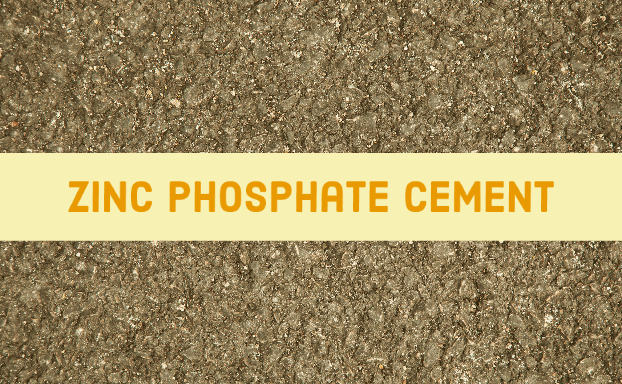Zinc Phosphate Cement is the oldest cement used in dentistry with the longest clinical track record. In this post we shall learn about Zinc Phosphate Cement.
This topic is usually asked for Short Answer Question (SAQ) in Dental Under graduate examination
It is usually available in Power & Liquid separate bottles. (2 Bottle System)
Composition of Zinc Phosphate Cement
Powder:
Zinc Oxide (90%)
Magnesium Oxide (10%)
Liquid:
Phosphoric acid
Water
Aluminium Phosphate
Zinc Phosphate
Setting Reaction of Zinc Phosphate Cement
As soon as the powder is mixed with liquid i.e. Phosphoric acid it attacks the surface of powder particles and releases zinc ions into the liquid. Already formed Aluminium and Phosphoric acid complex reacts with Zinc which yields Zinc Alumino Phosphate Gel.
Setting Time
It is defined as starting of mixing to which needle no longer makes circular indentation on cement. It is measured with 1mm diameter needle indenter under load of 400 gm and temp of 37 deg C, relative humidity > 90%
The setting time for zinc phosphate cement is:
2.5 – 8 min (According to ADA specification 96).
5.5 min (According to Phillip’s 12 ed. Table 14.2 Page 312)
Methods to increase the setting time of Zinc Phosphate Cement
- Reduce the power liquid ratio: This produces thinner mixture there by increases working and setting time but results in weaker cement
- Mixing Cement in increments
- Prolong the saturation of last increment: i.e. the more we mix the last increment the more matrix wall gets destroyed and the formation of Zinc Alumino Phosphate gel gets prolonged.
- Exothermic reaction between Powder and Liquid by cooling glass slab which retards the chemical reaction between Powder and Liquid.
Properties of Zinc Phosphate Cement
Setting time: 5.5 min
Film Thickness: 20 μm
Water/Powder Ratio: 1.4 gm powder with 0.5 ml liquid
Working time: 5 min (Start of mixing to maximum time viscosity is low enough to flow to form a thin layer of film)
Compressive Strength: 104 MPa
Tensile Strength: 5.5 MPa
Modulus of Elasticity: 13.5 GPa
Solubility in Water: 0.06 wt%
Pulp Response: Moderate
Reaction type: The setting reaction of this cement is Acid-base reaction
Retention: Caused due to mechanical interlocking of prosthesis to cement
Manipulation
One drop of liquid and powder is placed on glass slab. Liquid should be placed away from the powder. Powder is divided into several portions using flat blade of mixing spatula. Each portion (increment) is then added to the liquid and mixed in circular fashion for 15 to 20 seconds before adding another portion (increment). Mixing should be completed in 1.5 to 2 minutes.
Special Thanks to Dr. Vishakha Dare, MDS Prosthodontics for the contribution towards this post.
Last updated on April 7th, 2020 at 10:33


